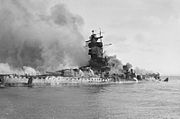
Chester William Nimitz was a fleet admiral in the United States Navy. He played a major role in the naval history of World War II as Commander in Chief, US Pacific Fleet, and Commander in Chief, Pacific Ocean Areas, commanding Allied air, land, and sea forces during World War II.

The United States Pacific Fleet (USPACFLT) is a theater-level component command of the United States Navy, located in the Pacific Ocean. It provides naval forces to the Indo-Pacific Command. Fleet headquarters is at Joint Base Pearl Harbor–Hickam, Hawaii, with large secondary facilities at Naval Air Station North Island, California.
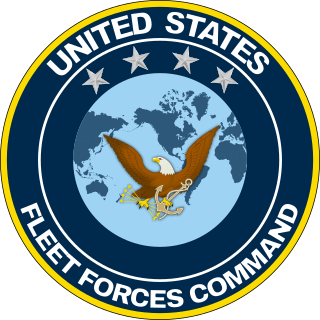
The United States Fleet Forces Command (USFFC) is a service component command of the United States Navy that provides naval forces to a wide variety of U.S. forces. The naval resources may be allocated to Combatant Commanders such as United States Northern Command (USNORTHCOM) under the authority of the Secretary of Defense. Originally formed as United States Atlantic Fleet (USLANTFLT) in 1906, it has been an integral part of the defense of the United States of America since the early 20th century. In 2002, the Fleet comprised over 118,000 Navy and Marine Corps personnel serving on 186 ships and in 1,300 aircraft, with an area of responsibility ranging over most of the Atlantic Ocean from the North Pole to the South Pole, the Caribbean Sea, Gulf of Mexico, and the waters of the Pacific Ocean along the coasts of Central and South America.
A destroyer squadron is a naval squadron or flotilla usually consisting of destroyers rather than other types of vessel. In some navies other vessels, such as frigates, may be included. In English the word "squadron" tends to be used for larger and "flotilla" for smaller vessels; both may be used for destroyer units. Similar formations are used in non-English-speaking countries, e.g., the "escadrille"—which would translate directly as "squadron"—in France.

Admiral Richmond Kelly Turner, commonly known as Kelly Turner, was an admiral of the United States Navy during the Second World War, where he commanded the Amphibious Force in the Pacific theater. Turner was also responsible for the creation of the Underwater Demolition Teams (UDT) in 1942 that were an early precursor to the United States Navy SEALs.

Vice Admiral Robert Lee Ghormley was an admiral in the United States Navy who served as commander, South Pacific Area during World War II. Ghormley was long considered to be an ineffective leader–overly cautious, pessimistic, and even defeatist–but recent scholarship has argued that while he may not have been an inspiring leader, he performed well enough under difficult circumstances.

Thomas Cassin Kinkaid was an admiral in the United States Navy, known for his service during World War II. He built a reputation as a "fighting admiral" in the aircraft carrier battles of 1942 and commanded the Allied forces in the Aleutian Islands Campaign. He was Commander Allied Naval Forces and the Seventh Fleet under General of the Army Douglas MacArthur in the Southwest Pacific Area, where he conducted numerous amphibious operations, and commanded an Allied fleet during the Battle of Leyte Gulf, the largest naval battle of World War II and the last naval battle between battleships in history.

Pacific Ocean Areas was a major Allied military command in the Pacific Ocean theater of World War II. It was one of four major Allied commands during the Pacific War and one of three United States commands in the Asiatic-Pacific Theater. Admiral Chester W. Nimitz of the U.S. Navy, Commander in Chief, U.S. Pacific Fleet, headed the command throughout its existence.

William Robert Munroe was a decorated officer in the United States Navy with the rank of Vice Admiral. He trained as submarine commander and at the beginning of World War II, he served as Commander, Battleship Division 3 during Neutrality Patrol in the Atlantic ocean.

Rear Admiral Frederick Lois Riefkohl, a native of Maunabo, Puerto Rico, was an officer in the United States Navy and the first Puerto Rican to graduate from the United States Naval Academy and to be awarded the Navy Cross. The Navy Cross is the second highest medal, after the Medal of Honor, that can be awarded by the U.S. Navy for heroism or distinguished service. He was a World War I Navy Cross recipient who served as Captain of the USS Vincennes during World War II.

Takeo Takagi was an admiral in the Imperial Japanese Navy during World War II. He was the commander of the IJN 6th Fleet, which oversaw the deployment of all submarines.
Sea Frontiers were several, now disestablished, commands of the United States Navy as areas of defense against enemy vessels, especially submarines, along the U.S. coasts. They existed from 1 July 1941 until in some cases the 1970s. Sea Frontiers generally started at the shore of the United States and extended outwards into the sea for a nominal distance of two hundred miles.
The Philippine Sea Frontier (PHILSEAFRON) was a United States Navy Sea Frontier active in 1941, and reformed in 1944.

The ANZAC Area, also called the ANZAC Command, was a short-lived naval military command for Allied forces defending the northeast approaches to Australia including the Fiji Islands, New Hebrides, and New Caledonia during the early stages of the Pacific Campaign of World War II. The command was created on 27 January 1942. United States Navy Vice Admiral Herbert Fairfax Leary commanded the force. The force co-existed with the Allied ABDA command which was charged with defending Allied colonial territories in Southeast Asia and the Southwest Pacific from Imperial Japanese aggression.
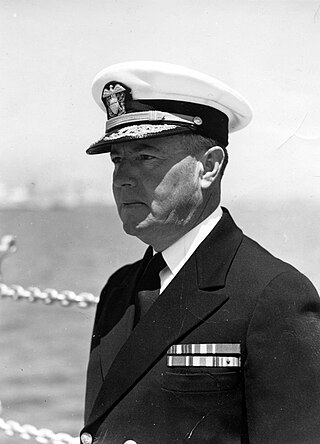
John Wills Greenslade was a highly decorated officer in the United States Navy with the rank of vice admiral. He enjoyed a significant military career, participating in several conflicts and distinguished himself during World War I as commanding officer, USS Housatonic and during World War II as commander, Western Sea Frontier and commandant, Twelfth Naval district with headquarters at Mare Island Naval Shipyard.
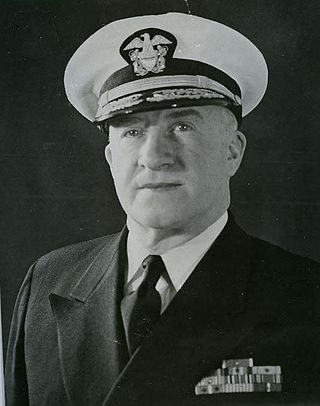
Earl Everett Stone was a rear admiral in the United States Navy. He is most noted for being the first director of the Armed Forces Security Agency, the predecessor to the National Security Agency.

Rear Admiral Herbert James Ray was an officer in the United States Navy who served in World War I and World War II. A 1914 graduate of the Naval Academy, he served on the submarines USS H-2 and N-3 during World War I. In March 1942, as Chief of Staff and Aide to the Commandant of the Sixteenth Naval District, Rear Admiral Francis W. Rockwell, he participated in General Douglas MacArthur's escape from the Philippines. In Australia, he served with MacArthur's General Headquarters, Southwest Pacific Area staff. In September 1943, he became Captain of the battleship USS Maryland, which he commanded in the Battle of Tarawa, Battle of Kwajalein, Battle of Saipan and the Battle of Peleliu. In October 1944, he participated in the Battle of Surigao Strait, in which Maryland joined the other battleships in engaging the Japanese battleships Fusō and Yamashiro and their escorts. Ray left Maryland in December 1944, and was promoted to Commodore and appointed deputy director of the Naval Division of the US Control Group Council for Germany. After VE Day, he became the Junior United States Member of the Tripartite Naval Commission in Berlin. He retired from the Navy on 30 June 1949, and received a tombstone promotion to rear admiral due to his combat decorations.

Bertram Joseph Rodgers was a highly decorated vice admiral in the United States Navy during World War II. He received his Navy Cross as captain of USS Salt Lake City in the battle of the Komandorski islands, during the Aleutian Islands Campaign.

Harold Cecil Train was a rear admiral in the United States Navy who served as the Director of the Office of Naval Intelligence between 1942 and 1943 and as commanding officer of the battleship USS Arizona. He was father of Admiral Harry D. Train II and grandfather of Rear Admiral Elizabeth L. Train.
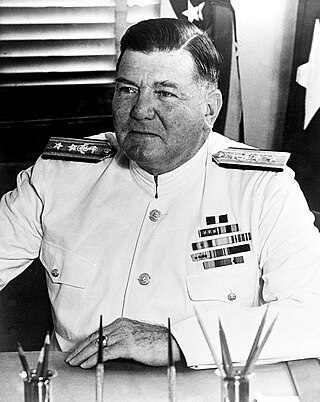
John Franklin Shafroth Jr. was a highly decorated officer in the United States Navy with the rank of Vice Admiral. He distinguished himself as Commander of destroyer USS Terry during World War I and received the Navy Cross, the United States Navy second-highest decoration awarded for valor in combat.


















